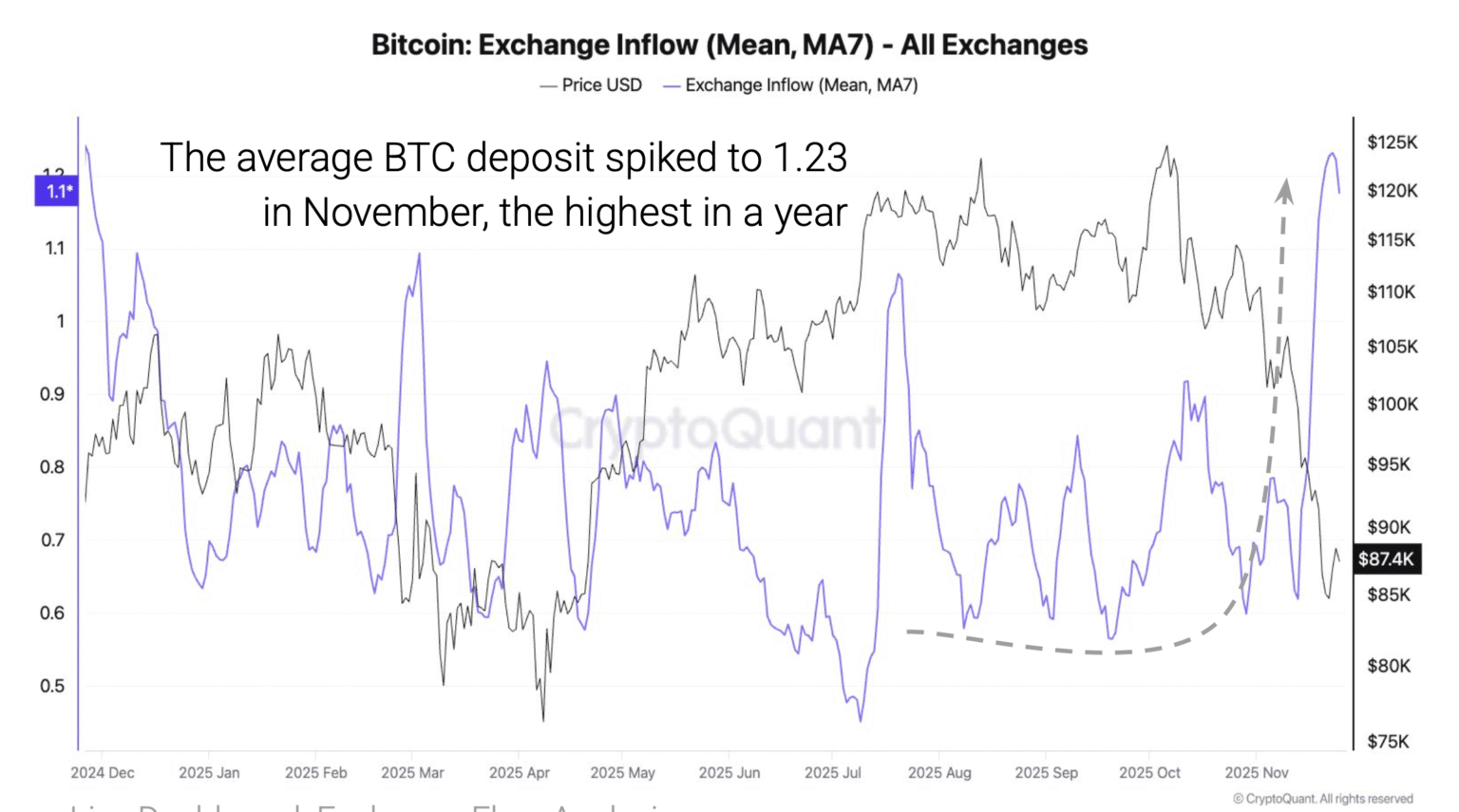Recent Bitcoin Exchange Activity: A Sign of Heightened Selling Pressure
In the aftermath of last week’s notable decline in Bitcoin prices, which saw values plummet to approximately $80,000, trading volumes on cryptocurrency exchanges have surged. According to CryptoQuant, an on-chain analytics firm, there was a significant uptick in Bitcoin being transferred to exchanges, with a total of 9,000 BTC sent on November 21 alone. Of this, 45% originated from large deposits of 100 BTC or more, marking a spike that the firm deemed unusually high. This increase in large transfers indicates a potential shift in market sentiment, where major holders might be looking to reduce their exposure to Bitcoin during this downturn.
CryptoQuant further elaborated on this trend by reporting a remarkable jump in the average Bitcoin deposit size, which surged to 1.23 BTC in November—its highest in a year—from a mere 0.6 BTC just a week earlier. This rise suggests that larger investors are increasingly engaging with exchanges to offload their Bitcoin holdings. This activity is critical as it plays an essential role in market dynamics. The high volume of these transactions suggests a sell-off that could contribute to continued downward pressure on Bitcoin’s price.
Focusing specifically on Binance, one of the largest cryptocurrency exchanges, the analysis found that the average deposit size had risen sharply from 12 BTC at the start of November to an impressive 37 BTC in recent days. This trend reinforces the idea that larger holders are taking proactive measures to decrease their Bitcoin exposure amidst a volatile market environment. As these large transactions dominate the inflows to exchanges, market watchers remain cautious, knowing such movements often precede price declines.
Understanding exchange flows is crucial for gauging market sentiment, especially in terms of buyer and seller dynamics. Julio Moreno, CryptoQuant’s head of research, emphasized this point by asserting that one can determine market activity by observing who is driving spot trading on exchanges. Since early October, sellers have consistently outnumbered buyers, contributing to a bearish market sentiment marked by red areas on trading charts. However, Moreno noted a slight shift in the last couple of days, suggesting a more balanced trading environment recently.
In addition to Bitcoin, other cryptocurrencies, particularly Ether and various altcoins, are also experiencing heightened exchange activity. CryptoQuant reported that while total inflows for Ether have not risen significantly, the average deposit size has soared to 41.7 ETH—the highest value seen in almost three years. This scenario unfolds as Ether’s price hovers around $2,900, reflecting the broader trends influencing major tokens in the market. The volatility of the cryptocurrency market propels speculation and trading, with major players adjusting their strategies based on prevailing price conditions.
The altcoin market has not been immune to this sales pressure either, as CryptoQuant noted that daily deposits of altcoins remain remarkably high. Since July, the total number of altcoin deposits has consistently surpassed 40,000 per day, peaking at 78,000 on October 17. This pattern indicates that the altcoin sector is also witnessing significant investor activity, mirroring the trends seen with Bitcoin and Ether during this ongoing price sell-off. As market volatility continues, trading strategies across the crypto landscape are poised for further evolution.
In conclusion, the recent surge in Bitcoin and cryptocurrency exchange activities underscores the heightened selling pressure felt throughout the market. With large traders taking significant steps to liquidate their positions, investors and analysts are closely monitoring these developments. A comprehensive understanding of exchange flows and their implications will be vital for market participants as they navigate the ever-changing landscape of cryptocurrency investment. The evolving trends in Bitcoin, Ether, and altcoins indicate that traders must remain vigilant as they make decisions in this increasingly dynamic environment.


